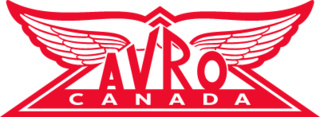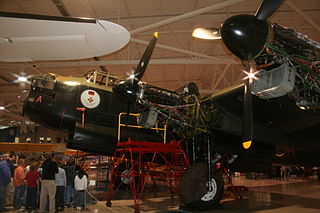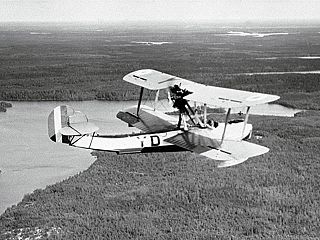
Avro Canada was a Canadian aircraft manufacturing company. It was founded in 1945 as an aircraft plant and within 13 years became the third-largest company in Canada, one of the largest 100 companies in the world, and directly employing over 50,000. Avro Canada was best known for the CF-105 Arrow, but through growth and acquisition, it rapidly became a major, integrated company that had diverse holdings.

The Handley Page HP.52 Hampden is a British twin-engine medium bomber that was operated by the Royal Air Force (RAF). It was part of the trio of large twin-engine bombers procured for the RAF, joining the Armstrong Whitworth Whitley and Vickers Wellington. The Hampden was powered by Bristol Pegasus radial engines but a variant known as the Handley Page Hereford had in-line Napier Daggers.

The Avro Canada CF-100 Canuck is a Canadian twinjet interceptor/fighter designed and produced by aircraft manufacturer Avro Canada. It has the distinction of being the only Canadian-designed fighter to enter mass production.

MET – Montreal Metropolitan Airport, formerly known as Montréal Saint-Hubert - Longueuil Airport or Montréal/Saint-Hubert Airport, and still commonly referred to as St-Hubert airport, is located in the Saint-Hubert borough of Longueuil, Quebec. The airport is located 16 km (9.9 mi) east of Downtown Montreal and 3 nautical miles east of downtown Longueuil.

Victory Aircraft Limited was a Canadian manufacturing company that, during the Second World War, built mainly British-designed aircraft under licence. It acted as a shadow factory, safe from the reach of German bombers.

The Fleet Finch is a two-seat, tandem training biplane produced by Fleet Aircraft of Fort Erie, Ontario. There were a number of variants mainly based on engine variations. Over several years beginning in 1939, a total of 447 Finches were built, nearly all (431) of them for use as elementary trainers in the British Commonwealth Air Training Plan (BCATP) during the Second World War.

The Bristol Fairchild Bolingbroke is a maritime patrol aircraft and trainer used by the Royal Canadian Air Force during the Second World War. Produced by Fairchild-Canada, it was a license-built version of the Bristol Blenheim Mk IV bomber.

408 Tactical Helicopter Squadron is a unit of 1 Wing, Kingston. It is co-located with 1 Canadian Mechanized Brigade Group at Canadian Forces Base (CFB) Edmonton.

Fairchild Aircraft Ltd. was an aircraft manufacturer active at Longueuil, Quebec, Canada in the period 1920–50. It served as a subsidiary of the Fairchild Aircraft company of the United States.

The Canadian Vickers Vedette was the first aircraft designed and built in Canada to meet a specification for Canadian conditions. It was a single-engine biplane flying boat purchased to meet a Royal Canadian Air Force (RCAF) demand for a smaller aircraft than the Vickers Viking with a much greater rate of climb, to be suitable for forestry survey and fire protection work. The type went on to have a long and distinguished career in civil operations in Canada. Most of the topographical maps in use in Canada today are based on photos taken from these aircraft.

The Canadian Vickers Vanessa was a Canadian biplane transport floatplane of the 1920s evaluated by the Royal Canadian Air Force (RCAF) and used briefly for delivering air-mail.

The Fairchild 71 was an American high-wing monoplane passenger and cargo aircraft built by Fairchild Aircraft and later built in Canada by Fairchild Aircraft Ltd. (Canada) for both military and civilian use as a rugged bush plane.

426 Transport Training Squadron is a unit of the Canadian Forces under Royal Canadian Air Force, located at CFB Trenton in Trenton, Ontario. It originated as a squadron in the Royal Canadian Air Force (RCAF) that fought during the Second World War as a bomber squadron.

The Fairchild Super 71 was a Canadian parasol-mounted high-wing monoplane cargo aircraft built by Fairchild Aircraft Ltd. (Canada). The Super 71 was an entirely new design that was one of the first purpose-built civilian bush planes for use in remote and northern locales in Canada.

The Fairchild 45-80 Sekani was a Canadian twin-engined transport aircraft developed in Canada in the late 1930s. Although the 45-80 was the largest bush plane developed by Fairchild, its poor performance doomed the project, and nearly the company.

No. 8 Squadron RCAF was a unit of the Royal Canadian Air Force (RCAF) that was in operation from 1936 to 1945.

National Steel Car Limited is the largest manufacturer of railway rolling stock in Canada, based in Hamilton, Ontario. The company was founded in 1912, and has been a top 3 rolling stock manufacturer in Canada for its lifetime. National Steel Car is a subsidiary of National Industries Inc. and is currently led by Greg Aziz, chairman and CEO of National Steel Car.
Air Defence Command was a command of the Royal Canadian Air Force and later the Canadian Armed Forces, active from 1951 to 1975.

FM213 is an Avro Lancaster, one of only two airworthy examples in the world. It was built in Malton, Ontario at Victory Aircraft as construction number 3414 and rolled out in July 1945. Built as a Mark X bomber, it was no longer needed in Europe and transferred directly to storage at CFB Trenton. It was later modified for maritime reconnaissance but damaged during delivery and underwent repairs in 1953. FM213 spent the next ten years as a search and rescue aircraft over the Atlantic Ocean.


















